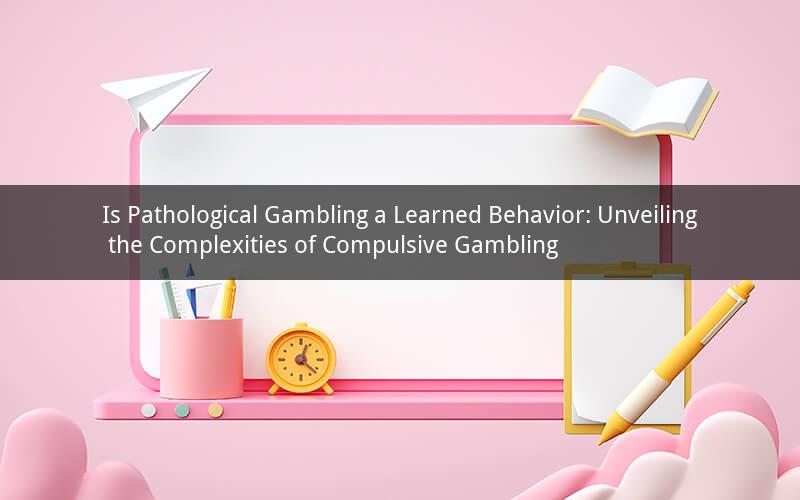
Introduction:
Pathological gambling, also known as gambling addiction, has been a topic of intense debate among researchers, clinicians, and the general public. One of the most debated questions surrounding this condition is whether pathological gambling is a learned behavior. This article delves into the complexities of this issue, exploring the various perspectives and research findings that shed light on this question.
1. What is Pathological Gambling?
Pathological gambling is characterized by persistent and recurrent gambling behavior that disrupts personal, family, and professional life. Individuals with this condition often experience a loss of control over their gambling activities, despite negative consequences. While some may argue that pathological gambling is solely a learned behavior, it is important to recognize that it is a complex disorder with multiple contributing factors.
2. The Role of Learning in Pathological Gambling
Proponents of the learned behavior theory argue that pathological gambling is acquired through a combination of learning processes, such as classical conditioning, operant conditioning, and observational learning. Here are some key points supporting this perspective:
a. Classical Conditioning: Gamblers may develop an association between certain cues and the anticipation of winning. For example, a person might become conditioned to associate a particular slot machine with the feeling of excitement and anticipation of winning.
b. Operant Conditioning: Gamblers may learn to reinforce their gambling behavior through rewards. The act of winning money or experiencing a thrilling sensation may become a reward that strengthens the desire to continue gambling.
c. Observational Learning: Individuals may observe others engaging in gambling and imitate their behavior, leading to the development of gambling addiction.
3. The Genetic and Biological Factors
While learning plays a significant role in the development of pathological gambling, it is important to acknowledge the influence of genetic and biological factors. Research suggests that certain genetic markers may predispose individuals to gambling addiction. Additionally, brain imaging studies have shown that individuals with gambling problems exhibit differences in brain structure and function compared to non-gamblers.
4. The Interplay of Social and Environmental Factors
Social and environmental factors also contribute to the development of pathological gambling. For instance, individuals who grow up in environments where gambling is normalized or encouraged may be more susceptible to developing gambling addiction. Additionally, individuals with mental health disorders, such as depression or anxiety, may turn to gambling as a form of self-medication.
5. The Importance of Early Intervention
Recognizing that pathological gambling is a complex disorder, early intervention is crucial. Treatment approaches should be comprehensive, addressing both the learned behavior aspect and the underlying factors contributing to the addiction. Cognitive-behavioral therapy (CBT) has been found to be effective in treating pathological gambling, helping individuals develop healthier gambling behaviors and coping strategies.
6. The Role of Education and Awareness
Education and awareness are essential in combating pathological gambling. By promoting understanding of the disorder and its risk factors, individuals can make informed decisions about their gambling habits. Moreover, raising awareness can help break the stigma associated with gambling addiction, making it easier for individuals to seek help.
7. Conclusion
In conclusion, while pathological gambling is influenced by learned behavior, it is a complex disorder with multiple contributing factors. Understanding the interplay of learning, genetic, biological, social, and environmental factors is crucial in developing effective prevention and treatment strategies. By recognizing the complexities of pathological gambling, we can work towards creating a supportive environment that helps individuals overcome this addiction and lead healthier lives.
Questions and Answers:
1. Q: Can pathological gambling be completely cured?
A: While there is no guaranteed cure for pathological gambling, with appropriate treatment and support, many individuals can achieve long-term recovery and lead fulfilling lives.
2. Q: Are all gamblers at risk of developing pathological gambling?
A: No, not all gamblers are at risk of developing pathological gambling. However, certain factors, such as a family history of gambling addiction or co-occurring mental health disorders, may increase the risk.
3. Q: Can pathological gambling be prevented?
A: Yes, prevention efforts can be effective in reducing the risk of pathological gambling. This includes promoting responsible gambling practices, providing education about the risks of gambling addiction, and addressing underlying factors that may contribute to the development of the disorder.
4. Q: How can someone recognize if they have a gambling problem?
A: Individuals with a gambling problem may exhibit signs such as lying about their gambling activities, spending excessive amounts of time and money on gambling, neglecting personal responsibilities, and experiencing negative consequences as a result of their gambling.
5. Q: Is there a difference between problem gambling and pathological gambling?
A: Yes, there is a difference between problem gambling and pathological gambling. Problem gambling refers to a mild form of gambling addiction, where individuals may experience some negative consequences but can still maintain control over their gambling behavior. Pathological gambling, on the other hand, is a more severe form of the disorder, characterized by intense gambling urges and significant negative consequences.